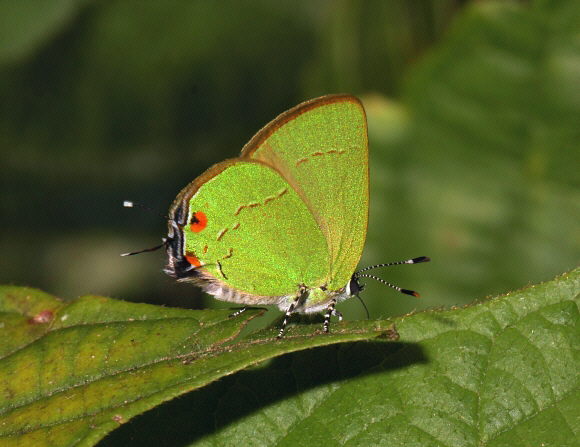
Introduction
Almost all neotropical Theclinae species are placed in the Eumaeini. The tribe is not particularly well represented in collections, so until fairly recently a high percentage remained unstudied, and were inappropriately filed away in the ‘convenience’ genus Thecla. Many taxonomists have attempted to rationalise the systematics of the Eumaeini, the most recent being Robbins who published a revision in 2004, reclassifying the taxa into 83 genera. Currently there are 1058 known species. Taking into account their small size, secretive behaviour, and the great similarities between many species, it is estimated that about another 200 species probably remain to be discovered.
Currently there are 33 known species of Erora, of which 13 have only very recently been described to science, and have not yet been allocated a species name. There is no doubt that more await to be discovered. All have metallic green undersides, and bear a filamentous tail on each hindwing, but the underside markings vary considerably from species to species.
The Mexican species quaderna for example is pale emerald green with numerous prominent orange crescents and chevrons on the hindwings, whereas gabina, opisena and carla all have bright apple green undersides with broken “hairstreak” lines, and black-pupilled red spots at the tornus.
Erora carla is distributed from Mexico to Peru. The numerous local forms varies considerably in the extent and intensity of the underside markings, although there are as yet no named subspecies.
Habitats
This species is found in tropical and subtropical forests, and is usually observed in disturbed areas where it can be found on bushes or other low vegetation.
Lifecycle
To be completed.
Adult behaviour
I have only observed males of this species. Some have been seen perching on the foliage of small bushes or low herbage, while others have adopted a rock-perching technique, sitting right at the tip of small rocks or boulders. When they take to the wing, the flight is very rapid, irregular, and almost impossible to follow with the eye, but the butterfly invariably resettles within a metre or two of it’s original perch, and can usually be relocated within a couple of minutes.
Often when I have encountered this species, it has been in slow but almost constant motion, walking about on rocks or leaves, usually in a fairly straight line, but with a very distinctive and irregular jiggling movement. From a couple of meters away this gives the impression of a bit of walking leaf – extremely reminiscent of a piece of leaf that is being transported over the ground in the jaws of a leaf-cutter ant.
